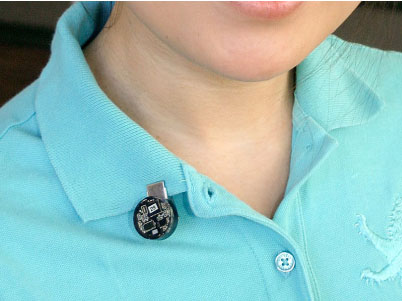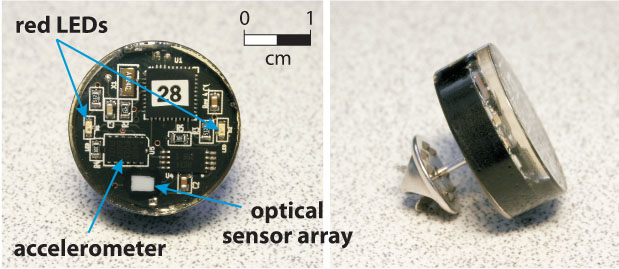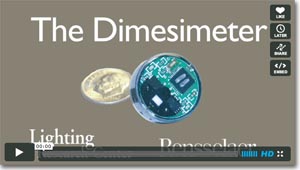The Dimesimeter
 The Dimesimeter was designed to be a small, unobtrusive and inexpensive data logging device, approximately 2 centimeters in diameter — slightly larger than the size of a US $0.10 coin — to record light and activity levels continuously over many days. It is a self-contained, epoxy-encapsulated, battery-powered, electronic device that communicates with a docking station via an optical interface to a personal computer. It can be worn by a subject in a variety of ways. It can be fitted with a pin for attaching to a shirt collar, lapel, or hat. Other versions include a wristband, a pendant, a badge, and a glasses clip.
The Dimesimeter was designed to be a small, unobtrusive and inexpensive data logging device, approximately 2 centimeters in diameter — slightly larger than the size of a US $0.10 coin — to record light and activity levels continuously over many days. It is a self-contained, epoxy-encapsulated, battery-powered, electronic device that communicates with a docking station via an optical interface to a personal computer. It can be worn by a subject in a variety of ways. It can be fitted with a pin for attaching to a shirt collar, lapel, or hat. Other versions include a wristband, a pendant, a badge, and a glasses clip.
The Dimesimeter is calibrated in terms of the spectral sensitivities of the visual and the circadian systems. Light sensing is performed with an integrated circuit (IC) sensor array that includes optical filters for three measurement channels: red (R), green (G), and blue (B). A monolithic IC accelerometer measures accelerations in each of three planes. It can be deployed for subsequent data download and analysis for continuous usage for up to a month.
 The Dimesimeter's small size enables researchers to examine light/dark and activity/rest patterns in groups who show circadian sleep disorders, such as Alzheimer's disease patients. In fact, Alzheimer's disease patients who are receiving a lighting intervention designed to improve their rest/activity patterns and increase their sleep efficiency are currently wearing the Dimesimeter. The device will help to determine their light/dark and activity/rest patterns before and after the lighting intervention, which was designed to maximally affect the circadian system during daytime hours. The Dimesimeter also provides researchers with an objective measure of daily and nightly light exposure levels. Finally, the RGB channels enable researchers to measure the chromaticity of the light sources experienced throughout the deployment period.
The Dimesimeter's small size enables researchers to examine light/dark and activity/rest patterns in groups who show circadian sleep disorders, such as Alzheimer's disease patients. In fact, Alzheimer's disease patients who are receiving a lighting intervention designed to improve their rest/activity patterns and increase their sleep efficiency are currently wearing the Dimesimeter. The device will help to determine their light/dark and activity/rest patterns before and after the lighting intervention, which was designed to maximally affect the circadian system during daytime hours. The Dimesimeter also provides researchers with an objective measure of daily and nightly light exposure levels. Finally, the RGB channels enable researchers to measure the chromaticity of the light sources experienced throughout the deployment period.
Phasor analysis, used to quantify circadian entrainment and disruption, is applied to the recorded light and activity data from the Dimesimeter as well as from a similar measurement device, the Daysimeter, also developed by LRC researchers.
The Dimesimeter's small size enables us to examine light/dark and rest/activity patterns in groups who show circadian sleep disorders, such as those with Alzheimer's disease. Scientists at the LRC are currently conducting experiments to test the accuracy of the Dimesimeter and compare its results to those of wrist acrigraphs and the Daysimeter; to test the acceptance of the Dimesimeter in patients with Alzheimer's disease and their caregivers; and to test the effect of a tailored light treatment for improving sleep quality of older adults.
We will continue to update the website with results of these experiments as they are available.
Watch a short video about the Dimesimeter

Publications
Dimesimeter- Light and activity measurement system description and calibration ![]()
New tools to measure light exposure, activity, and circadian disruption in older adults![]()
The Dime-simeter: A user-friendly circadian light meter![]()
Sponsors
National Institute on Aging grant # R01AG034157
To read more, search for related articles, or view a bibliography of published articles, click here.



